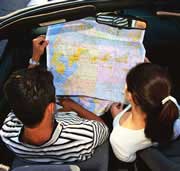Origami solves road map riddle

Computer model unfolds the map muddle. <br>© Getty Images <br>
Match up folds to fight stubborn paper.
No road journey is complete without a wrestle with the map. Now a US computer scientist has worked out why the map usually wins.
Erik Demaine of the Massachusetts Institute of Technology in Cambridge has come up with an origami algorithm that predicts when a stubborn street plan will be re-foldable. “It’s the meeting of paper folding and computer science,” he says.
The rules governing whether a sheet of paper divided into a grid of folds can be pleated back into a packet will confirm many motorists’ hunches.
Aligning mountain folds, protruding out of the sheet, and valley folds, poking inwards, is the key, Demaine told the meeting of the American Association for the Advancement of Science in Boston. “If they match up it’s guaranteed to work,” he said. “If they don’t, you’re toast.”
Crumpling the map into the glove box won’t help. A single 45° fold in the sheet, and the problem foxes even a computer, Demaine found. The models are probably little help to the harassed motorist, he admits.
Paper does not always follow predictions, warns mathematician Martin Kruskal of Rutgers University in New Jersey. Unlike a computer model, real paper has thickness – an A4 sheet is nearly impossible to fold in half more than six times. “Idealization has limitations,” he says.
Computational origami is attacking other seemingly intractable paper-folding challenges. The gift-wrapping problem – the smallest square of paper that can cover a regular object – challenges many at Christmas. Comfortingly, it has only been solved for wrapping a simple cube.
Such algorithms can also predict whether a three-dimensional object can be unfolded into a flat sheet. The sheet-metal industry uses the program in reverse to build furniture or cars from a single sheet. Computational origami also creates new designs for the Japanese art.
Media Contact
All latest news from the category: Transportation and Logistics
This field deals with all spatial and time-related activities involved in bridging the gap between goods and people, including their restructuring. This begins with the supplier and follows each stage of the operational value chain to product delivery and concludes with product disposal and recycling.
innovations-report provides informative reports and articles on such topics as traffic telematics, toll collection, traffic management systems, route planning, high-speed rail (Transrapid), traffic infrastructures, air safety, transport technologies, transport logistics, production logistics and mobility.
Newest articles

First-of-its-kind study uses remote sensing to monitor plastic debris in rivers and lakes
Remote sensing creates a cost-effective solution to monitoring plastic pollution. A first-of-its-kind study from researchers at the University of Minnesota Twin Cities shows how remote sensing can help monitor and…

Laser-based artificial neuron mimics nerve cell functions at lightning speed
With a processing speed a billion times faster than nature, chip-based laser neuron could help advance AI tasks such as pattern recognition and sequence prediction. Researchers have developed a laser-based…

Optimising the processing of plastic waste
Just one look in the yellow bin reveals a colourful jumble of different types of plastic. However, the purer and more uniform plastic waste is, the easier it is to…



